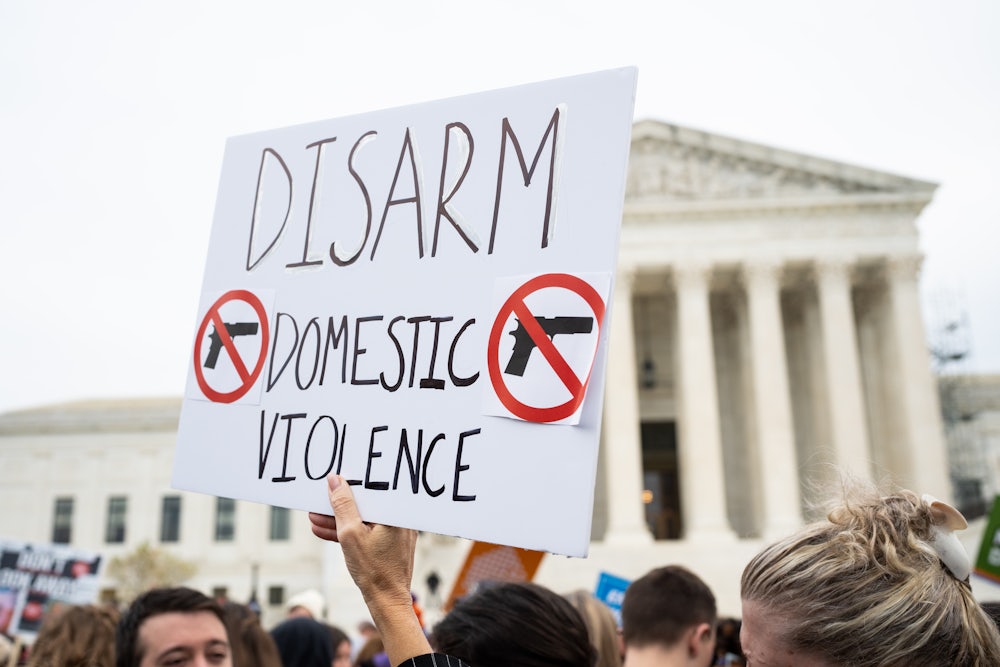Last year, the Supreme Court established a major new test for Second Amendment cases that promised to shake up how lower courts review gun restrictions. But in oral arguments in another gun case on Tuesday, the justices seemed to recognize that it had gone too far.
In hearing United States v. Rahimi, a clear majority of the justices appeared unwilling to strike down a federal law banning gun ownership for people under domestic violence protection orders. That law, along with dozens of other restrictions, was challenged after the justices in 2022 instructed lower courts to weigh whether existing gun restrictions had a “historical analogue.”
Justice Elena Kagan was perhaps the most blunt in her questioning of Matthew Wright, a federal public defender who argued on behalf of Zackey Rahimi, the man challenging the aforementioned law. “I’ll tell you the honest truth, Mr. Wright,” she said. “I feel like you’re running away from your argument, you know, because the implications of your argument are just so untenable that you have to say no, that’s not really my argument.”
Solicitor General Elizabeth Prelogar, who argued on behalf of the federal government, noted the immense potential stakes of a ruling in the defendant’s favor. “A woman who lives in a house with a domestic abuser is five times as likely to be murdered if he has a gun,” she told the justices toward the end of the session. Prelogar also pointed out that domestic violence calls are statistically among the most dangerous encounters for law enforcement and first responders.
The case originally began in a parking lot in Texas in 2019. Zackey Rahimi got into an argument with the mother of his child that turned violent. He dragged her to his car and threw her inside, where she struck her head on a dashboard. She only escaped after Rahimi saw an eyewitness, pulled out his gun, and tried to shoot them from a distance. According to federal prosecutors, Rahimi later called the mother of his child “and threatened to shoot her if she told anyone about the assault.”
A few months later, a Texas state judge issued a domestic violence protective order against Rahimi. A provision in federal law known as Section 922(g)(8) makes it a criminal offense to possess a firearm while under such an order, and Rahimi was duly notified that his license had been suspended. That apparently did not deter him. Not only did he try to communicate with the mother of his child while under the order, but he also allegedly took part in multiple shootings and assaults over the next two years.
Local police eventually apprehended Rahimi with multiple guns in his possession. Federal prosecutors charged Rahimi with violating Section 922(g)(8), and he received a six-year prison sentence for violating it. At trial, Rahimi had sought to dismiss the charges by arguing that the provision violated the Second Amendment, but the court rejected that argument by noting that the Fifth Circuit Court of Appeals had already upheld its constitutionality a few years earlier.
Then the Supreme Court handed down its ruling in New York State Rifle and Pistol Association v. Bruen last year. The 6–3 decision was the court’s first major Second Amendment case in more than a decade, and it proved to be a landmark one. Courts had previously scrutinized gun-related regulations by using a lower form of scrutiny that allowed judges to weigh the societal benefits of such a law. Justice Clarence Thomas had long complained that those rulings—and the court’s decade-long refusal to reconsider them—had rendered the individual right to bear arms a “second-class right.”
In his majority opinion in Bruen, Thomas put an end to that approach in favor of a new history-and-tradition test. “When the Second Amendment’s plain text covers an individual’s conduct, the Constitution presumptively protects that conduct,” he wrote for the court. “The government must then justify its regulation by demonstrating that it is consistent with the Nation’s historical tradition of firearm regulation. Only then may a court conclude that the individual’s conduct falls outside the Second Amendment’s ‘unqualified command.’”
The court’s new test effectively required lower court judges to sift through historical examples of gun regulations and decide whether current ones fell within a “historical tradition of firearm regulation.” As I have previously noted, the lower courts have struggled to implement the new test in a consistent and predictable manner, and Bruen has led judges to overturn even the most popular and well-established restrictions. Rahimi successfully persuaded the Fifth Circuit that 922(g)(8) should be one of them.
“Weighing those policy goals’ merits through the sort of means-end scrutiny our prior precedent indulged, we previously concluded that the societal benefits of § 922(g)(8) outweighed its burden on Rahimi’s Second Amendment rights,” Judge Cory Wilson wrote for the panel last year. “But Bruen forecloses any such analysis in favor of a historical analogical inquiry into the scope of the allowable burden on the Second Amendment right. Through that lens, we conclude that § 922(g)(8)’s ban on possession of firearms is an ‘outlier … that our ancestors would never have accepted.’”
The Justice Department asked the Supreme Court to intervene earlier this year. It argued that founding-era legislatures had taken steps to disarm those who were deemed “dangerous” by the community, including people with mental illnesses, those who committed felonies, and loyalists in the postrevolutionary period. While the concept of domestic violence as it is understood today did not exist in that era, the government argued that the founding-era approach to dangerous people in general could apply to it.
“Section 922(g)(8) fits within that history and tradition because it disarms persons who are not law-abiding, responsible citizens,” the government argued in its brief for the court. “Individuals subject to domestic-violence protective orders pose an obvious danger to their intimate partners because guns often cause domestic violence to escalate to homicide and because abusers often use guns to threaten and injure their victims.”
Prelogar urged the justices to clarify Bruen in three ways in the court’s eventual ruling. She said the court should emphasize that the original public meaning goes beyond just founding-era legislative actions, which would allow for a broader range of historical evidence to be used by judges. Prelogar also asked the court to elaborate more on when historical principles for limiting gun rights could be invoked. Finally, she asked the justices to instruct the lower courts that absence of regulation in a specific area should not affect the constitutional analysis.
“It’s contrary to the situation the Court confronted in Bruen where there was a lot of historical evidence to say states can’t completely prohibit public carry, and against that evidence, you might say that the absence of regulation is significant,” she told the justices. “But, here, there’s nothing on the other side of this interpretive question, and I think that that just shows that you shouldn’t hold the absence of a direct regulation against us.”
Some members of the court, notably Justices Neil Gorsuch and Amy Coney Barrett, appeared open to the idea of challenging specific applications of Section 922(g)(8) in future cases. But since Rahimi was challenging the provision’s overall constitutionality, they noted that approach couldn’t be taken here. Nor could Rahimi rely on due-process arguments against the process for handing down a domestic violence restraining order since he hadn’t raised it in the lower courts.
As a result, some of the court’s conservative members appeared to signal that they would narrowly uphold the provision in this case but leave the door open for more individualized challenges down the road. “I understand your answer to say that there will be circumstances where someone could be shown to be sufficiently dangerous that the firearm can be taken from him,” Chief Justice John Roberts told Wright. “Yes,” Wright replied. “And why isn’t that the end of this case?” Roberts continued. “All [we] need to do is show that there are circumstances in which the statute could be constitutionally applied.”
Justice Brett Kavanaugh, who signaled in a concurring opinion in Bruen that he might be willing to uphold certain gun restrictions in future cases, also pointedly observed on Tuesday that domestic violence protection orders are part of the federal background check process. “According to the government, under your argument, that system could no longer stop persons subject to those domestic violence protective orders from buying firearms,” he told Wright. While Wright disagreed, Kavanaugh did not appear to buy it. “So it’s possible the government’s correct in what it says?” he added after the lawyer’s explanation.
Prelogar, perhaps sensing that the justices were leaning in her direction, pointed to other troubling post-Bruen rulings in the lower courts in her rebuttal. Among them was a ruling by one court that invalidated the federal ban on gun ownership for people with felony convictions. “I think that those are clearly untenable results,” Prelogar argued. “They are profoundly destabilizing, and Bruen doesn’t require them. Once the court corrects the misinterpretation of Bruen, then I think the constitutional principle is clear. You can disarm dangerous persons. And under that principle, Section 922(g)(8) is an easy case.”
That the court took up the Rahimi case so quickly after it decided Bruen could be seen as a sign that the justices thought some cleanup was in order. The Supreme Court rarely takes the opportunity to revisit one of its landmark rulings so quickly, often preferring to let it percolate in the lower courts first. While oral arguments are an imperfect predictor of final outcomes, the justices gave no signs on Tuesday that they would let the post-Bruen fallout go on.










